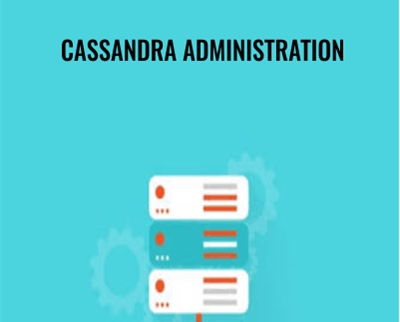$85.00 Original price was: $85.00.$33.00Current price is: $33.00.
Cassandra is the flagship product among the NoSQL databases with its distributed, fault-tolerant, extremely fast, linearly scalable, and low-cost features. These make it a high-calibre core component of the rapidly expanding cloud computing and mission critical data systems. This course shows you how to plan and prepare the right installation platform for a cluster and effectively administer Cassandra.
 Purchase this course you will earn 33 Points worth of $3.30
Purchase this course you will earn 33 Points worth of $3.30Elevate your skills with the Cassandra Administration – Packt Publishing course, available for just $85.00 Original price was: $85.00.$33.00Current price is: $33.00. on Utralist.com! Browse our curated selection of over 60,000 downloadable digital courses across diverse Uncategorized. Benefit from expert-led, self-paced instruction and save over 80%. Start learning smarter today!
Cassandra Administration
Configure and administer Cassandra for optimum database performance and a completely operational cluster
"Configure and administer Cassandra for optimum database performance and a completely operational cluster
About This Video
Quickly grasp the concepts behind Cassandra and understand its internal working mechanism
Build a single node cluster into a running multi-node cluster from scratch
Learn through clearly demonstrated steps how to administrate and manage day-to-day operations with Cassandra, including data migration, backup, restore, monitoring, and performance tuning
In Detail
Cassandra is the flagship product among the NoSQL databases with its distributed, fault-tolerant, extremely fast, linearly scalable, and low-cost features. These make it a high-calibre core component of the rapidly expanding cloud computing and mission critical data systems. This course shows you how to plan and prepare the right installation platform for a cluster and effectively administer Cassandra.
This quick-start video course covers administration tasks performed in real-world systems. It starts by providing you with a solid grounding in Cassandra architecture basics and then proceeds to build a single node cluster from scratch using step-by-step demonstrations. It then moves on progressively to show you how to build a completely operating multi node cluster.
This video course provides you with the necessary know-how to effectively administrate and perform operations in Cassandra. You will also get to know, from an architecture perspective, how Cassandra differs from traditional databases and other popular NoSQL databases.
The course starts off by showing you the steps to build your own cluster, and introduces you to the different use cases for Cassandra. Along the way, you will encounter caveats based on scenarios that may not be a good fit. After learning how to install Cassandra, you will learn how to use different monitoring tools and methods to import and export large amount of data. Next, primary and secondary indexes are explained to help you select the appropriate indexing that enables fast and efficient data lookup to respond to search and retrieval requests. Finally, you will use various tools to facilitate performance tuning, and conduct a stress test on a cluster, and interpret the performance results.
The course starts off by showing you the steps to build your own cluster, and introduces you to the different use cases for Cassandra. Along the way, you will encounter caveats based on scenarios that may not be a good fit. After learning how to install Cassandra, you will learn how to use different monitoring tools and methods to import and export large amount of data. Next, primary and secondary indexes are explained to help you select the appropriate indexing that enables fast and efficient data lookup to respond to search and retrieval requests. Finally, you will use various tools to facilitate performance tuning, and conduct a stress test on a cluster, and interpret the performance results."
Get Cassandra Administration – Packt Publishing , Only Price $37
Course Curriculum
Exploring Cassandra
- Apache Cassandra Overview (3:45)
- Features and Benefits (4:58)
- When Not to Use Cassandra (2:41)
- Other Similar NoSQL Databases (4:48)
- Differences from Relational Databases (4:29)
Basic Theory and Mechanism
- Understanding the CAP Theorem and Eventual Consistency (3:32)
- Creating the Data Model (3:23)
- Write and Read Paths (3:50)
- Understanding the Cluster Architecture (3:51)
- Detecting Seed, Gossip, and Failure (3:16)
Prerequisites and Preinstallation Preparation
- Preinstallation Planning (3:37)
- Single Node Preparation (3:53)
- Building from the Source Tarball (3:28)
- Installing and Configuring Cassandra (4:36)
- Building a Cluster of Multiple Nodes (4:09)
Monitoring Cassandra
- Logging and Log Rotation (3:28)
- The CLI Monitoring Tool — nodetool (4:27)
- The GUI Monitoring Tool — JConsole (5:00)
- Garbage Collection (3:53)
- System-Level Monitoring (4:30)
Data Migration and Indexing
- Loading Bulk Data (4:51)
- JSON Format Import and Export (4:03)
- Using the CQL Command — COPY (3:42)
- Using Primary Indexes (5:01)
- Using Secondary Indexes (4:54)
Backup and Restore
- Understanding Backup and Recovery Concepts (3:31)
- Taking a Snapshot (4:50)
- Incremental Backup (4:29)
- Using the Commitlog Feature (3:33)
- Using Restore Methods (3:56)
Performance Tuning
- Storage Strategies and OS Tuning (5:38)
- JVM Tuning (4:44)
- Caching Strategies (5:11)
- Compaction and Compression (6:12)
- Stress Testing (4:54)
Conclusion
- Repairing Nodes (5:40)
- Scaling In and Out (5:32)
- Supplement 1 — Cloning Virtual Machine (4:43)
- Supplement 2 — Installing and Configuring ClusterSSH (4:02)
- Closing Comments (2:27)
Get Cassandra Administration – Packt Publishing , Only Price $37
Tag: Cassandra Administration – Packt Publishing Review. Cassandra Administration – Packt Publishing download. Cassandra Administration – Packt Publishing discount. cassandra vs mongodb. cassandra install. cassandra docker. cassandra nodejs. data model cassandra.
Cultivate continuous growth with the Cassandra Administration – Packt Publishing course at Utralist.com! Unlock lifetime access to premium digital content, meticulously designed for both career advancement and personal enrichment.
- Lifetime Access: Enjoy limitless access to your purchased courses.
- Exceptional Value: Benefit from savings up to 80% on high-quality courses.
- Secure Transactions: Your payments are always safe and protected.
- Practical Application: Gain real-world skills applicable to your goals.
- Instant Accessibility: Begin your learning journey immediately after buying.
- Device Compatible: Access your courses seamlessly on any device.
Transform your potential with Utralist.com!
Related products
= 84 Points
Uncategorized
= 35 Points
Uncategorized
Optimizing Compliance and Maximizing Revenue for Ophthalmology and Optometry – Jeffrey P. Restuccio
= 85 Points
Uncategorized
Proven Fall Prevention Strategies: Exercise, Meds Management and Home Modification – Trent Brown
= 40 Points
Uncategorized
Managing Patient Emergencies: Critical Care Skills Every Nurse Must Know – Dr. Paul Langlois
= 85 Points
= 125 Points
Uncategorized
= 95 Points
= 84 Points






